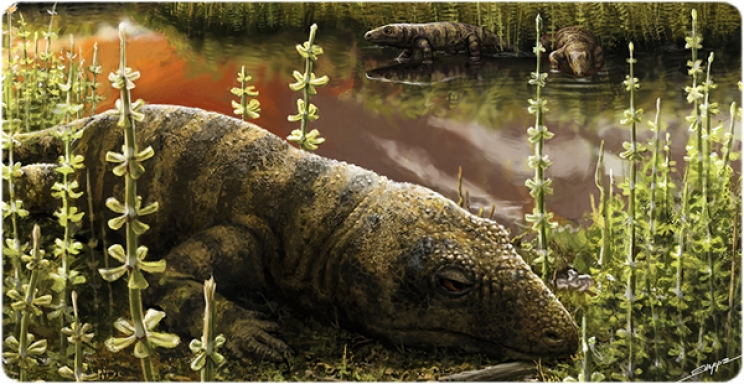The new reptile species is a moradisaurine captorhinid, a group of herbivorous reptiles that lived only during the Permian period, approximately from 299 to 251 million years ago, and have no living representatives. Within this group, Tramuntanasaurus tiai was a medium-sized species, measuring about 50 cm in length from head to tail; other species of this group reached lengths of up to 2 meters. Moradisaurine captorhinids are one of the most well-known Permian herbivorous tetrapods, but most of what is known about them is based only on recovered skulls from different locations around the world. This animals inhabited equatorial and tropical latitudes, possibly because they were better adapted to occasional arid conditions compared to other herbivores.
The studied fossil remains were found in Banyalbufar (Serra de Tramuntana, Mallorca) and are exceptionally well-preserved. "The animal is almost complete, with the different bones in anatomical position, which is quite exceptional in the fossil record of this period", explains Rafel Matamales, curator of Museu Balear de Ciències Naturals (MUCBO) and the first author of the research article published in the journal Papers in Palaeontology. Like other moradisaurines, their jaws show multiple rows of teeth . "We have observed that the tramuntanasaurs had five rows of teeth in the upper and lower jaw. This allowed them to chew and break down the plant material they consumed before ingesting it", explains the researcher.

Photograph of the specimen that has enabled the description of the new species. The scale bar is equivalent to 25 mm
The scientific name of the new species, "Tramuntanasaurus", means "the reptile from Tramuntana" and refers to the area where the fossil was found. The specific epithet, "tiai," is a tribute to Sebastià (Tià) Matamalas, the father of paleontologist Rafel Matamales, who discovered the skeleton. "During the fieldwork, my father, who was participating as a volunteer, saw something sticking out of the rock that looked weird to him. When he removed it, we could see the jaws and other bones of the skeleton", commented the paleontologist.
During the Permian period (approximately 270 million years ago), Mallorca was not an island, it was connected to the supercontinent Pangaea. This massive landmass had a crescent shape and extended from the North to the South Pole, encompassing almost all continents on the planet. Specifically, Mallorca was located on its eastern margin, relatively close to the sea, and at an equatorial latitude. "The climate was also quite different from now", explains Josep Fortuny, head of the Computational Paleobiology research group at the Institut Català de Paleontologia Miquel Crusafont (ICP), who also participated in the study. "The Tramuntanasaurus lived in a tropical climate where dry seasons alternated with very rainy ones", says the researcher.
The rock formations from the Permian period in Mallorca provide evidence of this climate. The fossil remains were found in an environment that corresponds to a landscape with large meandering rivers and associated floodplains. The Tramuntanasaurus remains were found in what was likely a temporary pond that may have acted as a watering hole during drier periods, attracting fauna from the surrounding area. "This explains the concentration of skeletons and footprints found in this zone", comments Eudald Mujal, paleontologist at the Museum of Natural History in Stuttgart, who also participated in the research. In the same fossil site, two different types of fossil footprints were found, suspected to belong to moradisaurine captorhinids. "Since the skeleton preserves the almost complete and articulated left foot, we were able to compare its anatomy with the footprints and are fairly confident that the smaller-sized footprints belong to the Tramuntanasaurus", Mujal states. In paleontology, it is extremely rare to find bones and footprints in close proximity to establish a correlation among them.
The description of the new reptile species T. tiai is another step forward in the great task of joint research carried out by the researchers at MUCBO and ICP in recent years in the fossil sites of Mallorca and Menorca. This research has allowed for the reconstruction of the fauna and paleoenvironment of this area during the Permian period. Previous studies had already revealed rich and diverse ecosystems with a wide representation of vertebrates, invertebrates, and plants.
This richness of fauna and flora would become extinct about 250 million years ago, during the most significant and devastating extinction event in the history of life on Earth, also known as "the great dying". "Intense volcanic activity altered the global climate of the planet in a geologically short period and led to the extinction of over 90% of marine species and 70% of terrestrial vertebrates", explains Àngel Galobart, director of the Museu de la Conca Dellà and co-author of the study. "This explains why a huge part of the faunas that lived at that time, such as the tramuntanasaurus, have no present-day representatives", concludes the researcher.
Main image: Recreation of the life appearance of three individuals (one adult in the foreground and two juveniles in the background) of Tramuntanasaurus tiai among horsetails (equisetums) in a Permian floodplain of Mallorca (Autor: Henry Sutherland Sharpe©)
Research article:
- Matamales-Andreu, R., Mujal, E., Galobart, À., & Fortuny, J. (2023). A new medium-sized moradisaurine captorhinid eureptile from the Permian of Mallorca (Balearic Islands, western Mediterranean) and correlation with the co-occurring ichnogenus Hyloidichnus. Papers in Palaeontology, e1498. DOI: 1002/spp2.1498















